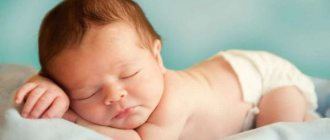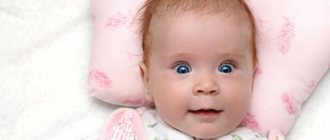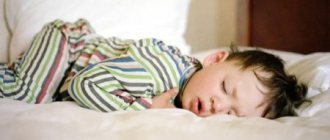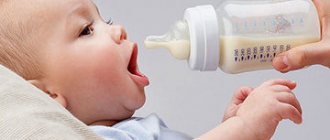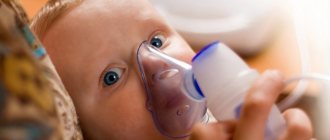A pillow is an indispensable attribute of a comfortable and pleasant sleep for almost all adults. With the birth of a baby, we begin to think: “Is it comfortable for him to sleep without a pillow? Does a baby need a pillow? When should you start using your pillow to sleep? And in general, what should it be, simple or orthopedic?” Let us hasten to reassure you - there is no need to rush with a pillow, especially if your baby is not even a year old.
Why can a pillow be harmful?
The main argument against using a pillow for a newborn is the following. In a dream, a baby can roll over on his tummy, bury his nose in a soft pillow and suffocate. After all, his neck is still too weak for him to support his head. In addition, the pillow, although soft, still holds the baby’s head in place. If, while lying on a pillow, the baby burps, he will not be able to easily turn his head, as his reflex dictates. Hence the risk of choking.
Also, some doctors believe that a soft, high pillow can negatively affect the formation of a baby’s spine, especially if the pillow is placed under the baby’s entire body. He should sleep on a fairly hard mattress. Instead of a pillow, it is recommended to place a flannel diaper folded in four under the baby's head.
However, pillow is not the same as pillow.
Does a child need a pillow after one year?
Whether a one-year-old child needs a pillow - expert opinions differ here. Some talk about the need for a pillow after a year, others advise going without it for as long as possible. Where is the truth?
There is no need to run for a pillow as soon as your baby turns one. Many orthopedists do not recommend using a pillow for up to one and a half, or even two years. And of course, there is no need to insist on your child using a pillow if he slides off it or throws it away in his sleep, or, perhaps, simply categorically does not accept the new accessory. A pillow for a 1-year-old child has a right to exist, but it must be thin, almost flat, elastic, and not too hard.
Orthopedic pillows
Above we talked about ordinary soft pillows in which the child literally drowns. However, there are special pillows designed for children with certain pathologies. For example, for torticollis, doctors recommend using a butterfly-shaped orthopedic pillow. The doctor may also recommend it if the baby suffered a cervical injury during childbirth. Another indication for the use of an orthopedic pillow is rickets. In these cases, a special pillow is necessary so that the baby’s cervical spine and neck bones form correctly, without deformation.
It should be noted that an ordinary, healthy child does not need a special orthopedic product.
Does a child under one year old need a pillow?
Young parents should know: according to the unanimous opinion of Russian and foreign doctors, as well as based on simple common sense, little ones do not need a pillow. Babies under one year old do not themselves express any particular desire to sleep on pillows; usually their use is the initiative of adults who think: he’s uncomfortable! We assure you: it’s comfortable, but just with a pillow it’s not. Yes, and not useful. In addition to the danger of suffocation, doctors also warn about the risks to the formation of the baby’s spine. A small child's head is significantly larger in proportion than that of an adult, so sleeping without a pillow does not cause overstrain in the baby's cervical spine. Regardless of the sleeping position, the baby's head and neck will lie correctly.
For children under one year old, a flannel diaper folded in four will be enough. It will provide a slight tilt of the body and moisture absorption (if the baby sweats or burps).
There are still exceptions to this rule. These are pillows designed specifically for newborns and babies up to one year:
- Inclined pillow . It makes breathing easier and provides protection during regurgitation in children under one year old. The angle of inclination of such a pillow should be no more than 30 degrees. You can achieve a similar effect by simply raising the mattress slightly at the head of the crib. If you use an inclined pillow, keep in mind that not only the head, but also the upper part of the child’s body should be located on it.
- Anatomical (orthopedic) pillow for children from birth to two years. Typically, the use of such a pillow is associated with the recommendations of a pediatrician and orthopedist. A special recess and small sides on the sides help fix the head in the desired position. Doctors recommend using an anatomical pillow for torticollis, displacement of the cervical vertebrae, or to prevent skull deformation if the child has a “favorite” head position.
- Anti-suffocation pillow . This modern invention will be a godsend for parents who are concerned about the risk of their newborn being suffocated by bedding. This pillow is made from breathable, porous polyurethane foam and is encased in a cotton cover. The design of the pillow is safe for the baby’s spine and is usually marked “0+”.
- Pillow for lateral support of a newborn . As you know, the lateral position is the safest for children under one year old. A pillow consisting of two blocks fastened together will help keep even the most active and restless babies in this position.
Pillow-mattresses
An amazing observation: you try to build some kind of structure for a baby, you suffer, and then you discover that everything was invented long before you. Same with baby pillows. How much time I spent trying to build something like a nest out of an ordinary sofa pillow and a blanket twisted into a flagellum in which my son would be comfortable. But then a bright thought came to mind - to look on the Internet.
It turns out that there are special pillows for newborns. Everything is done “according to science”: a soft but fairly elastic bottom, the sides are exactly the right height so that the baby cannot “jump” over them, accidentally turning over from the back to the side. And the main thing is the correct headrest, low, with a slight angle of inclination.
You can safely leave your sleeping baby on this pillow. Having woken up in a cozy nest, he will not immediately scream and call his mother, but will soak up for a few more minutes, giving mommy the opportunity to finish her business. In addition, you can rest assured that your baby is safe. It will not fall out of its “nest” - the sides are in the way.
In a word, all the useful things that a young mother might need have already been invented a long time ago and there is no need to reinvent the wheel.
When does a child need a pillow?
Many people are interested in the question: at what age does a child need a pillow? As we already wrote above, there is no clear answer from experts to this question. Focus on your child. If he doesn’t want to sleep on a pillow at one year, put it aside until the baby “ripes.” Some children, on the contrary, try to build themselves a pillow from a sheet or blanket in order to sleep like mom and dad. Take this moment and buy a pillow, but be sure to have the right one and one that is suitable for his age.
A standard baby pillow can be offered to a child as young as 2 years old. Before this age, the basic curves of the spine are formed, and by the age of two the baby will already need support for the cervical spine.
If we talk about ordinary, adult pillows, they can be used no earlier than a child’s age of 7-8 years.
What to look for when choosing a pillow for a newborn?
First of all - filler. The comfort of the baby most depends on it. Natural materials - down, feathers, wool - are not recommended. They can cause allergies. In addition, the wool quickly sheds and the pillow may lose its properties. “Exotics” like buckwheat are, of course, good. But you need to take into account that this material rustles. Not every baby will like this.
Fillers made from modern synthetic materials are practical. They hold their shape well and are easy to wash. The most budget option is comfort. The material is good, but not durable enough. However, such a pillow is enough for one or two children. Of course, you can’t count on long years of service. A more expensive option is latex (used in the manufacture of orthopedic pillows). Good material - polyester fiber: holds its shape and is easy to care for.
The pillow cover also matters. It is better to choose natural materials, most often cotton.
Be sure to follow the instructions for caring for the product. Then the first pillow will serve for the benefit of your baby for as long as necessary.
What kind of pillow does a child need?
Which pillow a child sleeps on is the choice of the parents alone. So that you do not get confused in the huge assortment of modern manufacturers, we note what you need to pay attention to when buying a pillow:
1) Material
The fabric of the pillow cover should be made of cotton or linen.
Materials used as filler are usually divided into natural and synthetic. The advantage of natural fillers is good breathability and environmental friendliness, but some of them can cause allergies. Synthetic fillers are good for their durability, but they can cause excessive sweating.
- Down and feathers are familiar filling materials, but they are far from the best for children due to allergenicity and excessive softness.
- Sheep wool is a natural material that retains temperature well. It stays cool in the summer and warm to sleep on in the winter. The disadvantage of such a pillow is that the wool quickly clumps. A compromise option could be a pillow made of sheep wool mixed with synthetics. In addition, sheep wool is an allergenic material.
- Holofiber is a filler that is loved by many for its elasticity and wear resistance. But, like all synthetic materials, it does not have the best air removal.
- Sintepon - pillows with such filling are among the cheapest and most short-lived. A child's head will sweat on such a pillow.
- Comforel is synthetic down with the addition of silicone fiber. Soft, like natural, but does not cause allergies.
- Lyocell is an innovative fiber made from wood. The advantage of this filler is the good heat dissipation of natural fillers, and such pillows can be washed, they are hypoallergenic and durable.
- Buckwheat husk is a material often used for orthopedic pillows. It has a massage effect and a head position memory effect. The downside is the rustling of such a pillow, which can interfere with the child’s sleep.
- Latex is one of the best fillers, hypoallergenic, and molds to the shape of the head. Such pillows promote correct sleeping position, which is why all orthopedists recommend them for use.
- Bamboo fiber is a natural material, durable and non-allergenic.
- Heat-sensitive viscoelastic polyurethane foam - dense and rigid. It is used for the production of orthopedic pillows, since it allows the pillow to maintain the anatomical contours of the human head.
- Polystyrene is a foamed polymer. Pillows made from it are hypoallergenic and lightweight. The material has medium hardness and is used for the manufacture of orthopedic pillows.
- Polyester (polyester fiber) is a lightweight, breathable synthetic material.
2) Breathability
This is an important characteristic both for the little ones, who can roll over and bury their nose in the pillow, and for older children, since a pillow with good air permeability will allow the head to “breathe.”
3) Elasticity
A traditional pillow should regain its shape after pressure. The softness and looseness of the pillow is the reason why you should not buy it for your child.
4) Material safety
Safety and environmental friendliness are important criteria for choosing a pillow for a child. Moreover, these characteristics must be taken into account both for the cover fabric and for the filler. You should not settle for the cheapest pillow; it is quite possible that harmful dyes were used in its production.
If your baby is prone to allergies, choose pillows made from hypoallergenic materials.
5) Size and shape
A traditional children's pillow, the pillowcases for which are included in the standard bedding set, has a size of 40*60. Orthopedic pillows have other sizes, usually slightly smaller than standard ones.
Classification of orthopedic pillows by age:
- up to 1.5 years: 18x25x2.5 cm
- from 1.5 to 3 years: 25x29x3 cm
- from 3 to 7 years: 35x39x5 cm
- from 7 years: 35x58x8 cm
The child does not need an adult pillow that is too large; it will simply be uncomfortable for the baby to sleep on it. When sleeping, only your head should be on the pillow, but not your shoulders, otherwise the whole point of supporting the cervical spine with a pillow is lost.
As for the shape, the pillow should be rectangular. Beautiful decorative pillows in the shape of animals, hearts and letters are an interesting option for decorating a nursery, but are not suitable for a child’s sleep.
6) Quality of seams
The stitching should be frequent enough, and the threads used to make the seams should be strong.
7) Presence of “zipper”
The zipper makes it easier to care for the pillow, allowing you to wash only the cover if necessary. In addition, with the help of a “zipper” you can control the amount and condition of the pillow filling.
A few more tips for choosing a mattress
The best option would be an environmentally friendly product that does not absorb or emit foreign odors, and is also well ventilated. It is allowed to use fillers made of coconut fiber, seaweed, horsehair, latex, and hollobiber.
USEFUL INFORMATION: I have a headache during the day after sleeping: what to do?
Criteria for choosing a mattress:
- moderate hardness;
- hypoallergenic materials;
- environmental friendliness, hygiene, ventilation;
- compliance with crib sizes;
- high-quality upholstery and the presence of a replaceable mattress cover that is easily washed.
The right mattress matches the dimensions of the crib. For infants, it is recommended to choose models that are slightly shorter than the length of the bed. This will make it easy to remove the product from the crib to dry. Lumps and unevenness will not appear on such a mattress. If you select a product that is too small, the child may be injured if an arm or leg gets caught in the hole between the mattress and the crib.
The ideal option is to buy a cocoon mattress. It can be installed on any suitable surface - sofa, floor, parent's bed - and the baby will be under supervision at all times.
